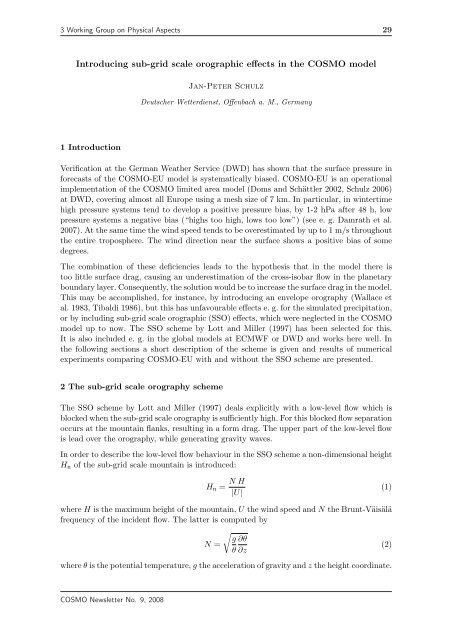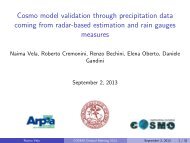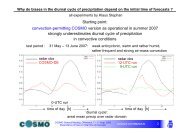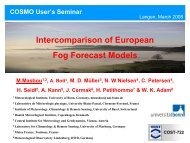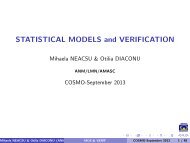3.1 - Cosmo
3.1 - Cosmo
3.1 - Cosmo
You also want an ePaper? Increase the reach of your titles
YUMPU automatically turns print PDFs into web optimized ePapers that Google loves.
3 Working Group on Physical Aspects 29<br />
Introducing sub-grid scale orographic effects in the COSMO model<br />
Jan-Peter Schulz<br />
Deutscher Wetterdienst, Offenbach a. M., Germany<br />
1 Introduction<br />
Verification at the German Weather Service (DWD) has shown that the surface pressure in<br />
forecasts of the COSMO-EU model is systematically biased. COSMO-EU is an operational<br />
implementation of the COSMO limited area model (Doms and Schättler 2002, Schulz 2006)<br />
at DWD, covering almost all Europe using a mesh size of 7 km. In particular, in wintertime<br />
high pressure systems tend to develop a positive pressure bias, by 1-2 hPa after 48 h, low<br />
pressure systems a negative bias (“highs too high, lows too low”) (see e. g. Damrath et al.<br />
2007). At the same time the wind speed tends to be overestimated by up to 1 m/s throughout<br />
the entire troposphere. The wind direction near the surface shows a positive bias of some<br />
degrees.<br />
The combination of these deficiencies leads to the hypothesis that in the model there is<br />
too little surface drag, causing an underestimation of the cross-isobar flow in the planetary<br />
boundary layer. Consequently, the solution would be to increase the surface drag in the model.<br />
This may be accomplished, for instance, by introducing an envelope orography (Wallace et<br />
al. 1983, Tibaldi 1986), but this has unfavourable effects e. g. for the simulated precipitation,<br />
or by including sub-grid scale orographic (SSO) effects, which were neglected in the COSMO<br />
model up to now. The SSO scheme by Lott and Miller (1997) has been selected for this.<br />
It is also included e. g. in the global models at ECMWF or DWD and works here well. In<br />
the following sections a short description of the scheme is given and results of numerical<br />
experiments comparing COSMO-EU with and without the SSO scheme are presented.<br />
2 The sub-grid scale orography scheme<br />
The SSO scheme by Lott and Miller (1997) deals explicitly with a low-level flow which is<br />
blocked when the sub-grid scale orography is sufficiently high. For this blocked flow separation<br />
occurs at the mountain flanks, resulting in a form drag. The upper part of the low-level flow<br />
is lead over the orography, while generating gravity waves.<br />
In order to describe the low-level flow behaviour in the SSO scheme a non-dimensional height<br />
H n of the sub-grid scale mountain is introduced:<br />
H n = N H<br />
|U|<br />
(1)<br />
where H is the maximum height of the mountain, U the wind speed and N the Brunt-Väisälä<br />
frequency of the incident flow. The latter is computed by<br />
√<br />
g ∂θ<br />
N =<br />
(2)<br />
θ ∂z<br />
where θ is the potential temperature, g the acceleration of gravity and z the height coordinate.<br />
COSMO Newsletter No. 9, 2008
3 Working Group on Physical Aspects 30<br />
A small H n will mean that there is an unblocked regime, all the flow goes over the mountain<br />
and gravity waves are forced by the vertical motion of the fluid. A large H n will mean that<br />
there is a blocked regime, the vertical motion of the fluid is limited and part of the low-level<br />
flow goes around the mountain. The SSO scheme requires four external parameters, which<br />
are the standard deviation, the anisotropy, the slope and the geographical orientation of the<br />
sub-grid scale orography. They are computed following Baines and Palmer (1990) from the<br />
same raw data set of orographic height which is also used for computing the mean orographic<br />
height in the model. This is currently the GLOBE data set (GLOBE Task Team 1999) which<br />
has a resolution of approximately 1 km.<br />
The two components of the SSO scheme, i. e. the blocking and the gravity wave drag, can<br />
both be individually adjusted, or even be switched off, by a tuning parameter. Generally,<br />
these two SSO parameters need to be adjusted depending on the mesh size of the model.<br />
For this study, the same two parameter values were chosen in COSMO-EU (mesh size 7 km)<br />
as in the DWD global model GME (mesh size 40 km). This setting yields already good and<br />
satisfying results. They may be further improved by an extensive tuning effort, but this is<br />
left here for a future study.<br />
3 Case study<br />
In order to test the SSO scheme in COSMO-EU two continuous numerical parallel experiments,<br />
running analogously to the operational analyses and forecasts, were carried out: A<br />
reference experiment of COSMO-EU without SSO scheme (called REF), and an experiment<br />
of COSMO-EU with SSO scheme (called SSO). The period was 25 Feb. – 31 Mar. 2008.<br />
Figure 1: Left: 10-m wind (m/s) and mean sea level pressure (hPa) (isolines) simulated by the<br />
reference COSMO-EU without SSO scheme, 26 Feb. 2008, 00 UTC + 00h. Right: Difference of 10-<br />
m wind (m/s) between COSMO-EU with and without SSO scheme (SSO - REF), same date. The<br />
difference flow is usually pointing in opposite direction than the flow itself (over land), indicating that<br />
the flow is slowing down due to the SSO scheme.<br />
COSMO Newsletter No. 9, 2008
3 Working Group on Physical Aspects 31<br />
Figure 2: Left: Mean sea level pressure (hPa) and geopotential at 500 hPa (gpdm) (isolines) simulated<br />
by the reference COSMO-EU without SSO scheme, 26 Feb. 2008, 00 UTC + 00h. Right: Difference<br />
of mean sea level pressure (hPa) between COSMO-EU with and without SSO scheme (SSO - REF),<br />
same date.<br />
Figure 3: Same as Fig. 2, but for 26 Feb. 2008, 00 UTC + 24h.<br />
This period was selected because several low pressure systems travelled through the model<br />
domain, providing good test cases for the SSO scheme.<br />
One of them was on 26 Feb. 2008 which is presented here. Figure 1 shows the mean sea<br />
level pressure for the REF experiment in the Northwestern part of the model domain on<br />
26 Feb. 2008, 00 UTC, at the beginning of the forecast, depicting a low pressure system<br />
over the Atlantic ocean, which was travelling eastward across Scandinavia during the next<br />
few days. The streamlines of the 10-m wind encircle the pressure system, with highest wind<br />
COSMO Newsletter No. 9, 2008
3 Working Group on Physical Aspects 32<br />
Figure 4: Difference of mean sea level pressure (hPa) between COSMO-EU with and without SSO<br />
scheme (SSO - REF). Left: 26 Feb. 2008, 00 UTC + 48h. Right: 26 Feb. 2008, 00 UTC + 72h.<br />
speeds southwest of the core, where the pressure gradient is high, and generally lower wind<br />
speeds over land. Differences in the 10-m wind between the two experiments (SSO - REF)<br />
are mainly found over land. The difference flow is usually pointing in opposite direction than<br />
the flow itself, well seen for instance over the British Isles, indicating that the flow is slowing<br />
down due to the SSO scheme.<br />
Figure 5: Bias of wind speed (m/s) versus forecast time (h) for the period 26 Feb. – 31 Mar. 2008,<br />
00 UTC runs. Blue: Reference COSMO-EU without SSO scheme (REF), red: COSMO-EU with SSO<br />
scheme (SSO). All stations in the model domain were used.<br />
Figure 2 shows the mean sea level pressure for the REF experiment in the full model domain,<br />
again on 26 Feb. 2008, 00 UTC. The low pressure system is clearly visible in the Northwest, in<br />
the Southern half of the domain, the mediterranean area, there stretches a region of prevailing<br />
high pressure. The geopotential at 500 hPa is overlaid as isolines showing the wave over<br />
COSMO Newsletter No. 9, 2008
3 Working Group on Physical Aspects 33<br />
Figure 6: Same as Fig. 5, but for bias of wind direction ( ◦ ). Blue: REF, red: SSO.<br />
Figure 7: Same as Fig. 5, but for root mean square error of mean sea level pressure (hPa). Blue:<br />
REF, red: SSO. The reduction of its error variance in SSO amounts to 16%.<br />
Northern Europe. In the beginning of the forecasts there are only very little differences in<br />
surface pressure between the two experiments. After 24h the low pressure system has moved<br />
further eastward (see Fig. 3). Pressure differences between the two experiments started to<br />
develop in a sort of dipole structure, the low pressure system in the North is filling up<br />
more efficiently in the SSO experiment compared to the REF experiment, the high pressure<br />
region in the South is weakening. This development continues during the further course of<br />
the forecasts while the low pressure system is moving eastward, Fig. 4 shows the pressure<br />
differences after 48h and 72h.<br />
This case study shows that the SSO scheme, particularly by increasing the form drag, enhances<br />
the cross-isobar flow in the planetary boundary layer, which as a consequence helps<br />
filling up low pressure systems and weakening high pressure systems.<br />
COSMO Newsletter No. 9, 2008
3 Working Group on Physical Aspects 34<br />
4 Numerical parallel experiments<br />
In this section an objective verification of the REF and SSO experiment is presented. Figure<br />
5 compares the biases of the wind speed versus the forecast time for the period 26 Feb. –<br />
31 Mar. 2008. The REF experiment shows a positive bias of up to 0.5 m/s, while the SSO<br />
Figure 8: Upper air verification for geopotential (top), wind direction (middle) and wind speed<br />
(bottom) for the period 26 Feb. – 31 Mar. 2008, 00 UTC runs. Dotted lines: Reference COSMO-EU<br />
without SSO scheme (REF), solid lines: COSMO-EU with SSO scheme (SSO). Left column: Bias,<br />
right column: Root mean square error. Black lines: + 00h, yellow lines: + 24h, blue lines: + 48h. All<br />
radio sondes in the model domain were used.<br />
COSMO Newsletter No. 9, 2008
3 Working Group on Physical Aspects 35<br />
experiment is basically bias free. The positive bias of the wind direction is reduced by about<br />
1 ◦ in the SSO experiment (Fig. 6). The root mean square error of the vector wind is reduced<br />
as well, and also the negative bias of the mean sea level pressure (not shown). In particular,<br />
the root mean square error of the mean sea level pressure is significantly reduced, namely,<br />
the reduction of its error variance amounts to 16% (see Fig. 7). This means that the pressure<br />
patterns are much better captured by COSMO-EU with the SSO scheme.<br />
Figure 8 presents an upper air verification of the two experiments with respect to geopotential,<br />
wind direction and speed. This shows a similar and consistent improvement of the<br />
model performance by the SSO scheme as well. COSMO-EU without the SSO scheme tends<br />
to develop a negative bias in the geopotential and a positive bias in the wind speed, both<br />
throughout the entire troposphere. Both biases are reduced by the SSO scheme. Furthermore,<br />
a positive bias in the wind direction in the lower troposphere is also getting smaller.<br />
Finally, the root mean square errors of all three quantities are slightly reduced as well.<br />
5 Conclusions<br />
The sub-grid scale orography scheme by Lott and Miller (1997) was implemented in the<br />
COSMO model. The scheme takes care of two different processes: a blocking of the low-level<br />
flow in case the sub-grid scale orography is sufficiently high, and a treatment of gravity waves<br />
excited in the flow over the mountains which will propagate through the atmosphere and<br />
eventually dissipate. Both processes tend to slow down the mean flow on different levels in<br />
the model. In particular the increased form drag results in an enhanced cross-isobar flow<br />
in the planetary boundary layer. As a consequence this weakens the development of high<br />
pressure systems and helps filling up low pressure systems.<br />
This behaviour of the SSO scheme was successfully tested in COSMO-EU in a selected<br />
case study. The objective verification of a continuous numerical experiment with the SSO<br />
scheme in COSMO-EU for the period 26 Feb. – 31 Mar. 2008 shows good improvements. In<br />
particular, the positive bias of the surface wind speed is basically removed, and the positive<br />
bias of the surface wind direction is reduced. The root mean square error of the mean sea<br />
level pressure is significantly reduced, namely, the reduction of its error variance amounts<br />
to 16%. This means that the pressure patterns are much better captured by the model. Not<br />
shown was that the negative bias of the mean sea level pressure is reduced as well, and also<br />
the root mean square error of the vector wind. In addition to the surface weather elements<br />
the upper air verification shows a similar and consistent improvement as well.<br />
Acknowledgement<br />
Thanks to Ulrich Damrath and Ulrich Pflüger, DWD, for their verifications.<br />
References<br />
Baines, P. G. and T. N. Palmer, 1990: Rationale for a new physically based parametrization<br />
of sub-grid scale orographic effects, European Centre for Medium-Range Weather Forecasts,<br />
Tech. Memo. 169, Reading, 11 pp. (Available at: http://www.ecmwf.int).<br />
Damrath, U., B. Brown and P. Nurmi, 2007: Different types of verification results required<br />
by different users, Presentation at the 3 rd International Verification Methods Workshop, 31<br />
Jan. – 2 Feb. 2007, Reading. (Available at:<br />
COSMO Newsletter No. 9, 2008
3 Working Group on Physical Aspects 36<br />
http://www.ecmwf.int/newsevents/meetings/workshops/2007/jwgv/workshop presentations/-<br />
U Damrath.pdf).<br />
Doms, G. and U. Schättler, 2002: A description of the nonhydrostatic regional model LM.<br />
Part I: Dynamics and Numerics, Deutscher Wetterdienst, Offenbach, 134 pp. (Available at:<br />
http://www.cosmo-model.org).<br />
GLOBE Task Team, 1999: The Global Land One-kilometer Base Elevation (GLOBE) Digital<br />
Elevation Model, version 1.0, National Oceanic and Atmospheric Administration, National<br />
Geophysical Data Center, 325 Broadway, Boulder, Colorado 80305, USA. (Digital data base<br />
available at: http://www.ngdc.noaa.gov/mgg/topo/globe.html).<br />
Lott, F. and M. J. Miller, 1997: A new subgrid-scale orographic drag parametrization: Its<br />
formulation and testing, Q. J. R. Meteor. Soc., 123, 101–127.<br />
Schulz, J.-P., 2006: The new Lokal-Modell LME of the German Weather Service, COSMO<br />
Newsletter, 6, 210–212. (Available at: http://www.cosmo-model.org).<br />
Tibaldi, S., 1986: Envelope orography and maintenance of quasi-stationary waves in the<br />
ECMWF model, Adv. Geophys., 29, 339–374.<br />
Wallace, J. M., S. Tibaldi and A. Simmons, 1983: Reduction of systematic forecast errors<br />
in the ECMWF model through the introduction of an envelope orography, Q. J. R. Meteor.<br />
Soc., 109, 683–717.<br />
COSMO Newsletter No. 9, 2008


